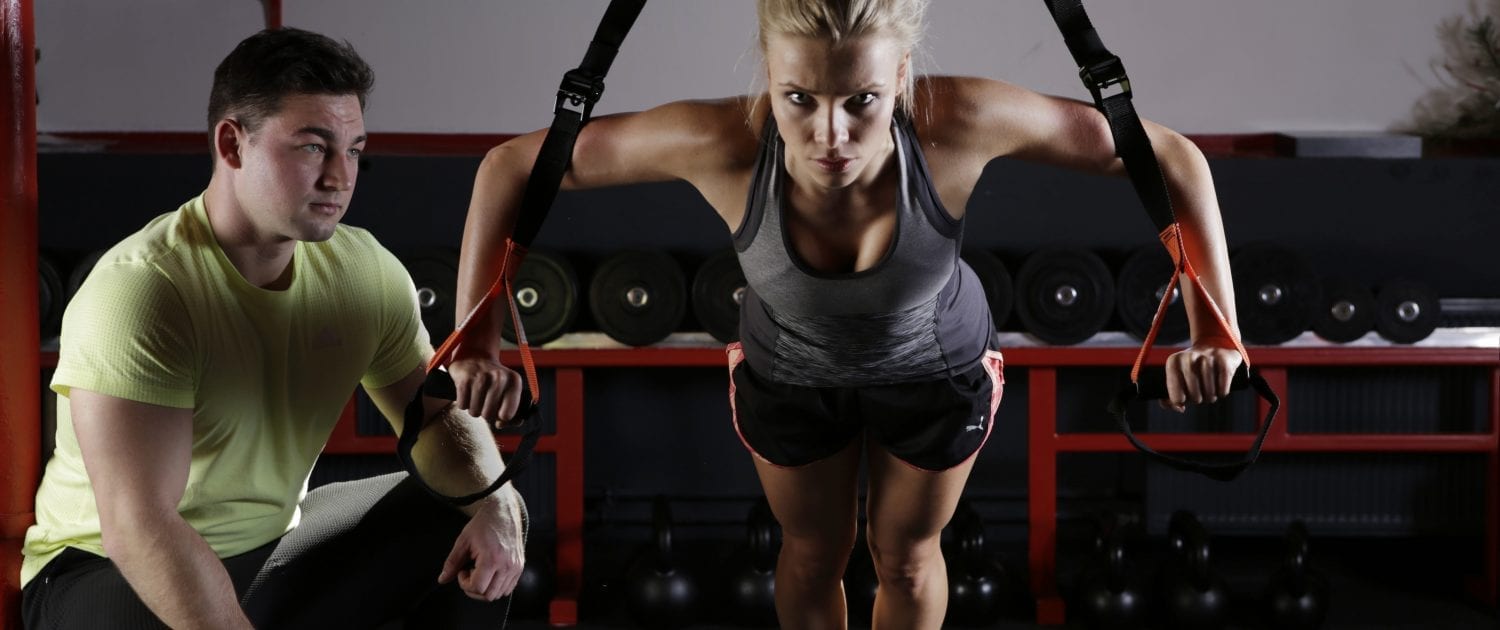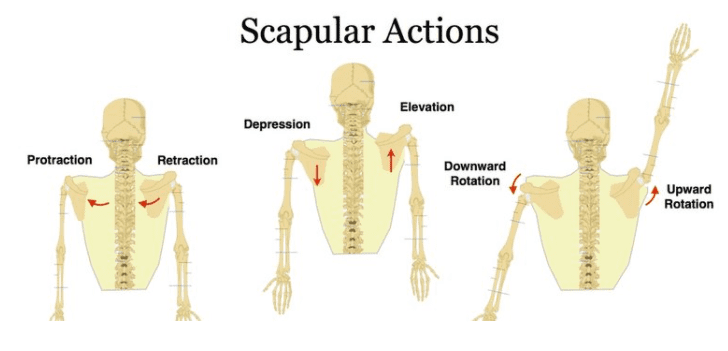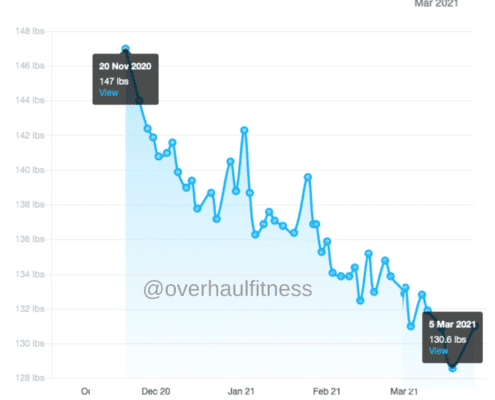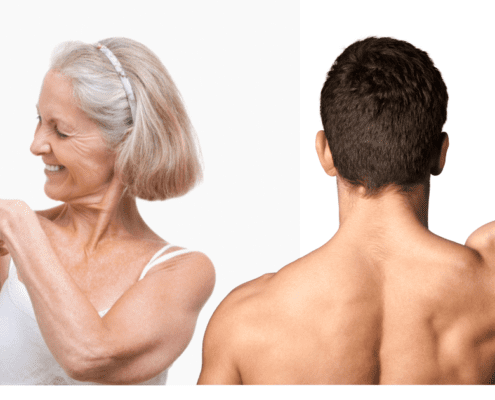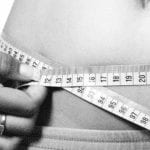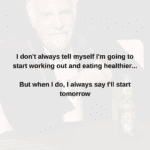8 Movements You Should Be Doing For Weight Loss
Last updated: Nov 15 2020 by Michael Fouts
Read time: 3 min.
Weight training is important when trying to lose weight, you don’t want to do cardio as your sole form of exercise; read this if you disagree or don’t understand why. When doing weight training for weight loss, and many other weight training related goals, you should focus mainly on compound movements (use more than one joint) and use exercises that target large muscle groups (eg. legs, back, core, chest).
Specifically for weight loss, you want to make sure you are getting the most “Bang For Your Buck” out of the exercises you are doing. Incorporating as many of the below 8 movements in your workouts will ensure this; movements 1 through 4 are named in relation to movement at the Chest/Shoulder.
1. Vertical Pull / Overhead Pull
Vertical pull exercises primarily target your upper back muscles, like your upper traps (Trapezius) and lats (Latissimus Dorsi); you’ll also secondarily target your biceps and forearms.
Example exercises: Pull-up, Seated Cable Lat Pulldown
Movement tips:
- perform the pull movement by thinking about corkscrewing your hands and pulling your elbows down and into your ribcage. For more information about how to properly do a Pull-up read this.
2. Horizontal Pull
Horizontal pull exercises also target your back, but have more emphasis on your mid-traps and the muscles between your shoulder blades (rhomboids).
Example exercise: Seated Cable Row, Dumbbell Rows
Movement tips:
- Your shoulder blade (scapula) should glide back and forth on your rib cage while performing the row. If you are doing a row with one arm, as you start the row (pulling the weight closer to your body) your shoulder blade should glide backwards (retraction) and “pinch” your spine. If you are using two arms then both shoulder blades should move at the same time and “pinch” an imaginary pencil between your shoulder blades.
- Make sure your shoulder blades are “tucked in your back pocket” (depressed) while doing horizontal rows.
FYI: your shoulder blade moves three ways (see picture below) 1. Up and down (shrugged, depressed) 2. glides forward and backwards on your rib cage (protraction, retraction) 3. Upward rotation, downward rotation.
3. Vertical / Overhead Press
Vertical presses are movements where you press weight vertically away from you, and primarily target your shoulder muscles (there are three).
Example exercise: Dumbbell Shoulder Press
Movement tips:
- Poor movement with overhead pressing is usually the result of lack of core engagement, poor shoulder flexibility, or both.
- Proper core engagement: sit “tall” and engage your core – brace as if someone was going to punch you. Keep your ribcage “stacked on top of your pelvis” throughout the overhead press. In other words, don’t let your lower back excessively arch while pressing and don’t let your ribcage flare out.
- Shoulder mobility: if your shoulder mobility is poor you can: do high incline presses (allows you to press less vertically), use neutral grip (palms facing inwards), or both. You can also work to increase your mobility with some shoulder mobility work.
4. Horizontal Press
The Horizontal press primarily targets your chest, but also incorporate your front shoulder and tricep (back of your arm).
Exercise example: Flat Bench Dumbbell Chest Press
Movement tips:
- This movement is the opposite to the horizontal row. As you start the press (pushing the weight away from your body) your shoulder blades should glide forwards (protraction) and away from each other. As you lower the weight (coming closer to your body) your shoulder blades will come closer together and come close to “pinching” that imaginary pencil between your shoulder blades.
- Just like with the horizontal row, you want to make sure your shoulder blades are “tucked in your back pocket” (depressed) while doing the pressing motion (you don’t want your shoulder blades hiked up and close to your ears).
5. Hip Hinge / Horizontal Hip Movement
Exercises that incorporate the hip hinge, are ones that horizontally move your hips. This movement targets the back of your legs (hamstrings), lower back, and your butt cheeks (glutes)!
Exercise example: Barbell Deadlift
Movement tips:
This one can get a little technical as this movement isn’t that common for most people. To read a more in-depth article about the deadlift, read this, but here’s some basic pointers:
- Start the movement by pretending to close a car door with your butt, by shooting your hips back.
- Keep your chest up and don’t round your lower back.
- Only lift the weight, pull the weight away from the floor, when your shoulder/chest is above your hip height (as viewed from the side); this will help prevent you from rounding your back.
- drive your hips forward and push into the ground, stand nice and tall and squeeze the butt-cheeks hard at the top.
6. Squat / Vertical Hip Movement
The Squat works your legs (front = quadriceps, back = hamstrings), and your butt cheeks – glutes; It also targets your core when doing vertically loaded exercises (carrying weight above the height of your belly) like the Barbell or Goblet Squat.
Example exercise: Goblet Squat
Movement tips:
The squat can also be a little technical, to read a more in-depth article about the squat, read this, but here’s some basic pointers:
- Everyone’s squat will look a little different due to anatomy differences.
- Start with shoulder-width stance, toes pointed forward. Try a bodyweight squat. If that doesn’t feel right, play around with taking a wider stance and/or toe-ing out (angle out your big toe) and try until something feels comfortable. Comfortable meaning where you can squat down to where your butt is the same height as your knees and you can hang out there feeling balanced with equal pressure throughout your triangle foot – see next point.
- As you descend into the squat apply pressure into the ground with your triangle foot (big toe, pinky toe, and heel). While maintaining these pressure points, drive your knees outwards.
- Aim for a squat depth of butt around knee height (break parallel).
- Push into the ground through your triangle foot and ascend out of the squat.
7. Lunge
Like the Squat, the lunge also targets the legs but more so the front of the legs (quadriceps) and butt cheeks (glutes).
Example exercise: Alternating Bodyweight Lunge, or something more advanced: Contralateral Dumbbell Front Loaded Reverse Lunge (video below)
Movement tips:
- Depending on the lunge variation you are doing you’re going to take a comfortable step forward/backward – this doesn’t have to be that far, more people often take too large of a step.
- Push into your heel as you land your foot, don’t let it creep up as you land. If you lack ankle mobility then take a little larger of a step.
- Your knee can go over your toes, that’s a myth. What’s important is that your shin angle matches your torso (you don’t want an upright torso while your knee is over your toe).
8. Carry
Simply put, hold something heavy and carry it while walking. Doing the carry properly requires you to use your shoulders, back, core, and leg muscles.
Example exercise: Farmers Carry
Movement tips:
- Keep an upright torso, don’t slouch.
- Squeeze your armpits to stabilize your shoulder and make holding the weight easier.
- Walk with good heal-to-toe fashion and pressure
If you need any help critiquing your workout program to include these 8 movements or some In-person instruction on how to do them properly, myself or one of my trainers would be happy to help.
Till next time,
-Mike
Interested In Being A Client?
Click Here and fill out a quick interest form and we’ll be in touch!
Or…Stay In Touch
Join everyone else that we email, no more than once per month, to keep in touch about recent blog posts, new workout programs, meal plans and recipes to try, and more…

